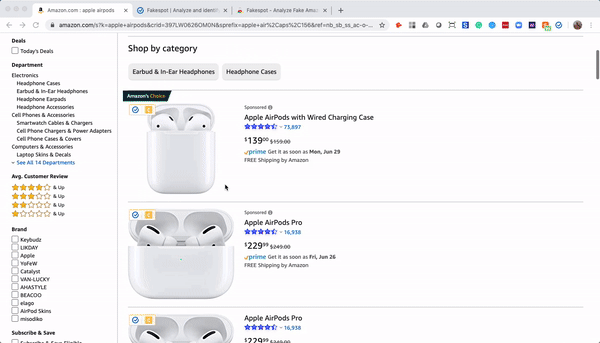As wonderful as the internet can be, it also lies to us every day. Fake reviews—seemingly legitimate assessments created by a seller or someone paid by them—are becoming harder to spot. With online shopping continuing to skyrocket, fake reviews are big business, but they can end up costing you serious money.

In a survey of 1,000 US shoppers who planned to buy tech on Amazon Prime Day last year, only 16% of respondents were very confident they could detect fake Amazon product reviews; 24% were confident they could do it. Most—33%—were somewhat confident they could suss out bogus write-ups; the rest were not confident or not at all confident they could pick out the fakes.

Why is this important? In that same survey, 78% of people said Amazon product reviews play a big role in their purchase decisions. If we can't trust these online reviews—and the recent discovery that over 200,000 people were involved in a fake reviews scheme with third-party Amazon vendors suggests we cannot—how are we supposed to decide what to buy?
We would, of course, recommend that you consult our comprehensive reviews across multiple categories before making a tech purchase. We review more than 2,000 tech products a year and have experts who know their markets inside and out. However, outside of that, there are a few telltale signs a review may not be genuine. And if you really can't tell them apart, you can turn to some helpful online tools to help clear things up.
What to Look For

As you peruse Amazon, be on the lookout for reviews that actually provide context for the rating that is given, don't plug competitor products, and use natural-sounding language.
Reviews that are overly positive or negative without offering enough detail can be suspicious. Very brief five-star and one-star reviews, particularly if they're all posted on the same day, may also denote suspicious activity.
In order to combat fake reviews, Amazon adds a Verified Purchase label to reviews where the reviewer has actually purchased the product. However, this does not take into account schemes where reviewers are compensated for legitimate purchases.
If you happen across a review you believe is fake, you can report it to Amazon, and mark it for investigation and possible removal. Just click the Report abuse under the review.
Fakespot

Fakespot rates how reliable product pages are on Amazon, Best Buy, eBay, Sephora, and Walmart. Fakespot’s algorithm looks at reviews and reviewers, analyzing language, previous reviews, and purchase history to determine trustworthiness.
Just copy the URL of the page in question and paste it into the Fakespot Analyzer to investigate a link. For this story, we'll test the listing for the Amazon Echo Show 5, a PCMag Editors' Choice award winner. Once the Amazon link is added, Fakespot spits out a grade that should tell us whether the page has reliable information.

It also filters out reviews considered fake in order to create a more reliable product rating. Amazon users have given this product a 4.7-star rating, but after running it through Fakespot, the adjusted rating is closer to 3.5 stars. Fakespot also gave the URL a C review grade, signifying the reviews on this page may be at least somewhat unreliable.
A Chrome extension allows online shoppers to analyze web pages with the push of a button, as well as access seller ratings and other benefits. Fakespot is also available via iOS and Android apps, which analyze mobile web page URLs users plug in.

Paste an Amazon URL into the ReviewMeta search bar, and the website will eliminate reviews it deems unreliable and replace Amazon's aggregate rating with one from ReviewMeta. So our 4.7-star test product is cut down to 4.1 stars after 87% of potentially unnatural reviews are removed.
ReviewMeta provides a report card that evaluates certain criteria on a Pass, Fall, or Warn basis. There are also detailed breakdowns—complete with graphs—for the factors contributing to the adjusted rating. Keep in mind that this website can only process a product's first 10,000 reviews because Amazon hides all additional reviews from view.
This tool also offers the unique ability to tweak ReviewMeta's algorithm in order to weigh certain criteria more or less than the default configuration. After the website analyzes a page, click View/Edit Adjustment to go into the grading mechanics and adjust how categories are weighted.
Add the browser extension for Chrome, Firefox, or Edge to quickly analyze a web page and receive a Warn/Pass/Fail grade. Analyze pages from your phone with the iOS and Android apps.
TheReviewIndex

TheReviewIndex is a simple online search tool focused on aggregating tech product ratings on Amazon, but it can still determine if a product's score has been boosted by fake reviews. Chrome and Firefox extensions that make the process easier.
Paste the URL into the site and TheReviewIndex breaks the product out into different categories based on the words it parsed from reviews. At the same time, TheReviewIndex runs a spam test to ensure that the reviews are authentic, providing a Pass/Fail grade at the end.
Looking at our test product, The Review Index gave it an 8/10 score and a passing spam grade, but only analyzed the most recent 998 reviews. You can then read through pulled clips—both positive and negative—that fit under the different product categories, and view the factors that go into spam testing.
Get Our Best Stories!
Sign up for What's New Now to get our top stories delivered to your inbox every morning
This newsletter may contain advertising, deals, or affiliate links. Subscribing to a newsletter indicates your consent to our Terms of Use and Privacy Policy. You may unsubscribe from the newsletters at any time.
"Review" - Google News
May 13, 2021 at 01:09AM
https://ift.tt/3uNnP1e
How to Spot a Fake Review on Amazon - PCMag
"Review" - Google News
https://ift.tt/2YqLwiz
https://ift.tt/3c9nRHD
Bagikan Berita Ini














0 Response to "How to Spot a Fake Review on Amazon - PCMag"
Post a Comment